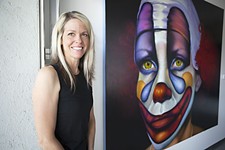Studio Visits: Akirash
This intermedia artist from Nigeria isn't satisfied unless his studio includes his backyard
By Andy Campbell, Fri., May 10, 2013
GALLERY
∨ JUMP to INTRO ∨ < 1 of 10 >

CREDIT: Andy Campbell
Artists scrub up for Big Medium's semiannual art tours – artworks are hung and presented neatly on white walls on a consistent median line, studios are tidied, and artists stand ready for a barrage of informal conversations about their work. As exhilarating and exhausting as it is for the nomadic art-curious wandering from location to location, it's even more so for the studio-bound artists themselves. If exhaustion is inevitable, though, you wouldn't know it talking to Olaniyi Akindiya, one of the very few intermedia artists on the West Austin Studio Tour this year. Akindiya, whose nom de brush is Akirash (because "it's easier to say"), is equally deft at producing impastoed, stringy paintings as he is large-scale public sculpture or immersive and beguiling performances. His trajectory is global: Born in Nigeria, he moved to New York City via Ghana and now roosts in Austin. During our interview, we never actually got inside his studio, but we covered a lot of ground between his living space and backyard.
Akirash: I love materials, as you can easily see.
Austin Chronicle: Yeah, obviously! How do you see your role as an artist?
A: I remember in 2001, when I moved from Nigeria to Ghana, I went to exhibition openings, and I noticed that people would walk, walk, walk. They were going toward the food table; they eat and they drink, and then they're out. I always asked myself, "Why can't we discuss one or two of the works?!" But I think I should not blame these people, I think I should blame myself as an artist – perhaps I need to create works that bring debates. So this makes me challenge myself with materials. And I use everything around me, so that you stop and remember me. In my studio in Accra, [Ghana,] people would find things like bottle caps and bring them to me – I would tell them, "You know what? I'd like you to keep this until you have one hundred, then invite me and we'll make something together in your own place – and it becomes yours."
AC: So your studio practice is somewhat mobile. Can you tell me a little bit about this space? Is it your studio?
A: Yes, this is my studio. Well, actually, it's in the back, but it's a mess!
AC: Can I see it?
A: No! [Laughs]
AC: Why not?! It's okay if it's a mess ...
A: Well, let's go out back [laughing]. My backyard is part of my studio. I work on the ground, using these plywood surfaces to paint on. This work [points to large towers of milk crates] is called Hope, and it's in the form of a key. Everyone looks for hope. Kids come here and play on it, and you can climb on it. Really! I've been trying to donate it as a public artwork for Austin, but the process isn't going anywhere at the moment.
AC: Could you have made work like this when you were in New York?
A: When I was in New York, I would see a lot of artwork, and I asked myself "What am I doing?" and my friends would ask me, "Why are you even asking yourself that question?" They would say, "We're always proud of you and looking at your work." But I was not so satisfied. If Picasso had been satisfied, today we wouldn't be looking at his work. If I was satisfied, I would have stayed in Nigeria, and my work wouldn't have changed.
AC: So was it dissatisfaction that convinced you to make the move from New York to Austin?
A: Well, my studio was so small in New York.
AC: But it seems like your works are so large, on such a scale that wouldn't be supported by a small space...
A: Yes! Exactly. When I moved to Austin, the space changed.
More of Akirash's work can be found at www.artwithakirash.com.










